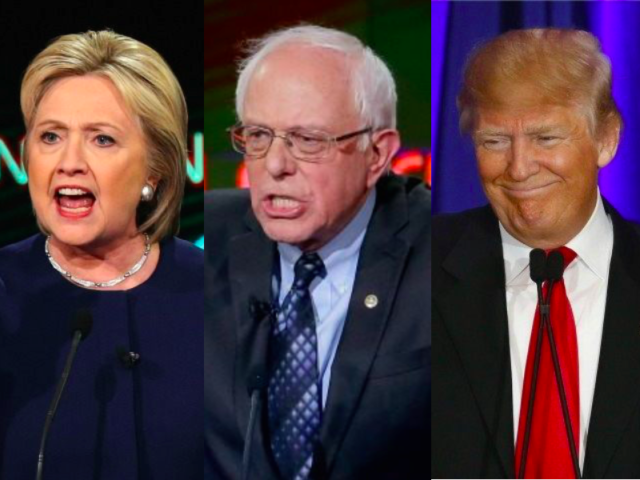Today, Californians will finish a primary election that really has been taking place for almost a month, when the first round of absentee ballots were mailed out.
Turnout is expected to be high. As Breitbart’s Michelle Moons reported, “California now has the highest voter registration in its history at nearly 18 million, with over 646,000 registrations in just 45 days…”.
As the results come in from this largest and last-in-the-nation primary, here are five different things to be looking for as the results come in.
1. SANDERS VS. CLINTON
Breitbart California editor Joel Pollak observes:
Clinton needs fewer than 30 delegates from California and the other handful of small states that will be voting on Tuesday to clinch the Democratic Party’s presidential nomination. An early favorite to win in California, she is thought to lead among early voters, who have been mailing in their ballots for weeks. Yet she could lose among Election Day voters, or even lose overall, and it would not matter: she will be the party’s nominee.
The Associated Press, in fact, called the nomination for her on Monday evening. So the question isn’t whether Clinton clinches the nomination today, it’s whether she suffers an embarrassing blow to her candidacy with a Sanders statewide win.
Sanders has been closing the gap in recent weeks, but will it be enough to overcome those ballots cast earlier in the month when Clinton had a bigger lead? We will see. If Sanders does win, you can be sure he will use the win to continue to his ideological crusade on the left, and make it more difficult for Clinton to consolidate Democrats heading into the fall showdown against the presumptive Republican nominee, Donald Trump.
2. GOP SHUT OUT OF U.S. SENATE RACE?
At the time that Congresswoman Barbara Boxer won her U.S. Senate seat in 1992, edging out television commentator Bruce Herschensohn, California was a competitive state for Republicans statewide. A generation later, we are in a solidly blue state where Democrats currently hold every single statewide office. The blue state blues of the California GOP may sink to a new level soon, thanks to the 2010 passage by voters of Arnold Schwarzenegger’s “top two” election system, replacing the old traditional primary process. Except for the office of President, in every other partisan race in California every candidate appears on the June ballot — and the top two vote-winners then advance to the November general election. This is regardless of the political party of the candidates.
There have been a number of races in which the top two candidates in the runoff have been either two Democrats (most of the time) or two Republicans (less often). But due to a perfect political storm, it is very possible that for the first time, a statewide race, and for a very important office, will be a single party affair.
The two leading Democrats, Attorney General Kamala Harris and Congresswoman Loretta Sanchez, have both raised millions of dollars and spent heavily heading into today’s election. On the GOP side there are a host of GOP candidates but because none of them are raising appreciable amounts of money to engage in meaningful voter contact, it is likely that votes from Republicans will end up being diluted amongst them. The recent Field public opinion survey of likely primary voters had Harris at 30%, Sanchez at 14%, and no Republican current with more than 4% of the vote. The X factor is the 27% of likely voters who have not yet made up their minds. There is some added irony here in that one of the candidates, former GOP State Chairman Duf Sundheim, had been a strong advocate and supporter of the new top-two system — a system that may dash his Senatorial dreams today.
3. GOP TURNOUT FOR TRUMP
Not too long ago we were looking at a donnybrook of a GOP primary in California, with Donald Trump and Senator Ted Cruz duking it out (with Ohio Governor John Kasich tap-dancing at the edges). But all that has now changed, and Trump is the proverbial “last man standing” for the Republican nomination — like Mitt Romney four years ago, or Senator John McCain four years before that. Yet despite having the nomination sewn up well in advance of the California primary in 2012, Romney received just less than 80% of the Republican vote.
So we will be looking at two different metrics to figure out how Trump is being received by Republicans — both the results in terms of a percentage, and also GOP turnout. These numbers, while not consequential in terms of Trump’s taking the nomination, are basically a huge Republican opinion survey in a state with more Republicans than any other.
It is also possible, though unlikely, that a few congressional districts might not go with Trump. This happened to McCain in 2008, where he had sewn up the nomination but three House districts went with Romney, and thus a small group of Romney delegates went to that year’s convention in Minneapolis.
One thing is certain: after today, all eyes will turn to this summer’s national conventions, and the general election beyond.
Jon Fleischman is the Politics Editor of Breitbart California. A longtime participant, observer and chronicler of California politics, Jon is also the publisher at www.flashreport.org. You can follow him on Twitter at @flashreport and email him at jon@jonfleischman.com.

COMMENTS
Please let us know if you're having issues with commenting.